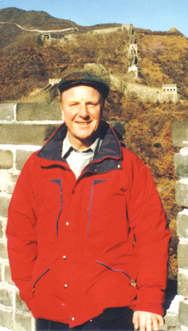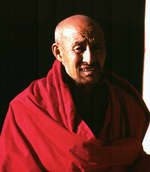 I have been very fortunate to have many opportunities to travel to dif-ferent areas of China, taking pho-tographs and recording the rapid changes that have happened in recent years.
I have been very fortunate to have many opportunities to travel to dif-ferent areas of China, taking pho-tographs and recording the rapid changes that have happened in recent years.
I first came here in 1987. At that time my interest was rail travel. I travelled by train all the way from Glasgow, Scotland to Hong Kong. An incredible journey that I called 'The Ultimate Dream - a Rail Journey to China'. Travelling south from Mongolia to Beijing I was increasingly fascinated with the diversity of China - the desert, the loess lands of Shanxi and the spectacular scenes of the Great Wall at Badaling Pass. Beijing with its palaces, temples and of course, Tiananmen Gate was a photographer's dream.
The journey south, crossing the Yellow and Yangtze Rivers, was a journey to the tropics. A land of rice fields, water buffaloes and little villages. I was totally transfixed for the entire journey down to what was still the old city of Guangzhou. At that time China was just starting to open up to the outside and move away from a land of intermediate technology. However, it was obvious that great changes were about to happen because the train passed through Shenzhen. In disbelief I asked, "Is this still China?" Of course it was! Bordering Hong Kong this wasswheresmodern China was being created. China has reformed in many ways since then. I am glad to have witnessed the economic and social progress from the south east coast to the deep interior of the country.
In 1992 my life changed. I was seconded for one year from my teaching post in Scotland to a college in Guangzhou. Guangdong Foreign Languages Normal School trained students from Guangdong Province to become English teachers. An unforgettable experience with enthusiastic students whose dedication to learning convinced me that China was really going to move ahead. A later article will talk about my experiences at the college and highlight the advance that has been made from traditional teacher-based learning to the use of the most advanced educational technology.
I was amazed at how quickly Guangzhou had changed in only five years. No longer a sleepy trading port on the Pearl River (Zhujiang) it was rapidly being transformedsintosthe dynamic modern capital of an increasingly economically powerful province.
My year in Guangzhou provided wonderful travel opportunities at a time when tourism was just starting in many places. Often I was the first foreigner to visit some places. This was particularly thanks to my students who regularly took me to their towns and villages in Guangdong's lush countryside. I discovered a richness of life ranging from fishing islands in the South China Sea to remote mountain areas that were home to some of China's distinct nationalities. It was an exciting opportunity for a photographer to be with the colourful Yao people living in villages bordering Guangxi Province.
 Many times I have returned to Guangzhou and watched the expansion of the city upwards and outwards. Quality of life has indeed changed dramatically for the people in recent years.
Many times I have returned to Guangzhou and watched the expansion of the city upwards and outwards. Quality of life has indeed changed dramatically for the people in recent years.
During 1993's Spring Festival I took the boat to Haikou and travelled around Hainan Island. Although only nine years ago tourism was still in its infancy and often I had the place to myself. Haikou was fascinating with its distinctive architecture influenced by foreign contact along the Maritime Silk Route. A journey south along a new expressway took me to the developing beach resorts around Sanya, Dadonghai and Yalong Bay. Inland I discovered the tropical forests around Five Finger Mountain (Wuzhishan) - the scenically beautiful lands of the Li and Miao People. The sun setting over the rice padis around the Li town of Tongzha with its mountainous backdrop has remained an unforgettable memory.
 In January this year I was invited back to Haikou to prepare a report on the city's appearance today and to make comparisons with 1993. Haikou Television also interviewed me on this subject.
In January this year I was invited back to Haikou to prepare a report on the city's appearance today and to make comparisons with 1993. Haikou Television also interviewed me on this subject.
Although I had to return to Scotland in August 1993 my heart was firmly in China. I knew I wanted to return and travel to more places in this vast country. At every opportunity, several times each year I came back. Although I spent a lot of time in the south, my journeys increasingly took me to the interior, particularly the South West. An ambition fulfilled was a journey down the 'Long River' (Changjiang) from Leshan in Sichuan to Hankou in Hubei. Six days watching and recording life along one of the World's greatest rivers. Magnificent scenery and the site of one of the World's greatest engineering projects, the Three Gorges Dam.
The South West has so much natural beauty. Guangxi, for example, is a region I call 'Heaven on Earth'. Although well known for its stunningly beautiful limestone scenery around Guillin and Yangshuo it also has a fabulous tropical coastline. Beihai, a busy fishing port with distinctive South China architecture is being developedsintosa major holiday resort and provides many excellent photo opportunities.
Yunnan is an area that has attracted me back many times. Spending a few weeks there in 1995 I realised there was so much to see that long visits were necessary. Yunnan drops from high plateaux bordering Tibet down to dense tropical forests shared with Burma, Laos and Vietnam. With 26 distinctive ethnic nationalities it is a traveller's dream. Each area has its own unique architectural style and eachsgroupswears a different style of costume. Particularly fine is the walled town of Dali, the home of the Bai people. Sitting below Cangshan Mountain and close to the shore of Lake Erhai it has a stunning location. Nearby small towns such as Shaping and Wase have crowded colourful weekly marketsswheresBai women often carrying back baskets continue their traditional lives to the delight of the visitor.
A few hours north is Lijiang, home of the Naxi people and well known for its canals that flow through the pedestrianised, very picturesque Old Town. Shortly after my first visit, a devastating earthquake hit the town. I was personally very upset that this could happen to such a beautiful place. Thankfully the town has been rebuilt in its original style and today is a relaxing place to visit with its streets and alleys lined with wonderful small cafes.
To the north of Lijiang rises the great mass of Yulongxueshan or 'Jade Dragon Snow Mountain'. On the far side of the mountain is one of the World's deepest canyons, the Tiger Leaping Gorge, cut by the massive force of the Jinshajiang ('Gold Sand River') - the local name for the Changjiang. Many times I explored this incredible areaswheresthe size of man is totally dwarfed by nature. This truly spectacular area borders on a high-plateau of Tibetan farming villages, monasteries and lakes. Formerly known as Zhongdian, it often uses the name 'Shangri la', or 'Land of Eternal Youth'. Certainly walking through the meadows covered with flowers under a really clear blue sky I felt I had regained my youth there!
In 1997 I retired early from teaching in Scotland and came back to Beijing to set off on a three-month journey to the Lake of Heaven. A fulfilment of an ambition I had kept since 1987. My destination was Tianqi or 'Heaven Lake' in the glacial Heaven Mountains (Tianshan) of far western Xinjiang. This expedition mainly by train took me through many places still only infrequently visited by westerners. Going north west from Beijing I explored the grasslands of Inner Mongolia, the ancient land of Ningxia, the Silk Road province of Gansu, the high plateau of Qinghai and finally the mountains and deserts of Xinjiang. Back in Britain my photographs informed many people of the beauty and contrast of this vast region. Xinjiang's Turpan, the second lowest place in the World; the end of the Great Wall at Jiayuguan in Gansu and the colourful Buddhist Ta'er Monastery in Qinghai are some of the great memories from that journey.
Since childhood I had the dream that some day I would stand in front of Lhasa's Potala Palace. Recently that dream was fulfilled when I travelled through Tibet with the destination being the World's highest mountain, Qomolangma (Mt Everest). Not to climb, just to look! Very interesting was South East Tibet, an area quite different to the common images of the region. This was a land of forested mountains, cascading rivers and spectacular glacial lakes. Indeed it is often compared to Switzerland or Western Canada.
Of course China is a rapidly changing country. Major cities are changing virtually overnight. This is particularly true in ShanghaiswheresI have watched with amazement the growth of the spectacular Pudong district. From farmland only a few years ago it now has one of the World's most impressive and distinctive skylines. Yet, although increasingly modern, Shanghai still has many places of beauty and tranquillity, such as the Yu Yuan Gardens.
Now I spend most of my time in Beijing, walking every day through different parts of this huge city. With its transformationsintosa modern international capital there is a lot of interest for a photographer. Recording the past before it disappears and capturing the many new faces and images of the city keeps me busy. However, when I want to return to some of my favourite places in China I simply have to go to Beijing's Ethnic Minorities Park. A short walk takes me from Dali to Lijiang. Then I can wander through Xinjiang's fascinating towns and spend some time resting in a Mongolian tent ('ger').
I have been very privileged to see China emerging from its past and changesintosthe modern society of today. I have also been fortunate to share so much with the ordinary people who have introduced me to their lives in towns and villages throughout the country. It has been a pleasure for me to share my experiences through my photographs with many people in my own country, Scotland.

![]() 本网站由北京信息港提供网络支持
本网站由北京信息港提供网络支持
 I have been very fortunate to have many opportunities to travel to dif-ferent areas of China, taking pho-tographs and recording the rapid changes that have happened in recent years.
I have been very fortunate to have many opportunities to travel to dif-ferent areas of China, taking pho-tographs and recording the rapid changes that have happened in recent years. Many times I have returned to Guangzhou and watched the expansion of the city upwards and outwards. Quality of life has indeed changed dramatically for the people in recent years.
Many times I have returned to Guangzhou and watched the expansion of the city upwards and outwards. Quality of life has indeed changed dramatically for the people in recent years. In January this year I was invited back to Haikou to prepare a report on the city's appearance today and to make comparisons with 1993. Haikou Television also interviewed me on this subject.
In January this year I was invited back to Haikou to prepare a report on the city's appearance today and to make comparisons with 1993. Haikou Television also interviewed me on this subject.